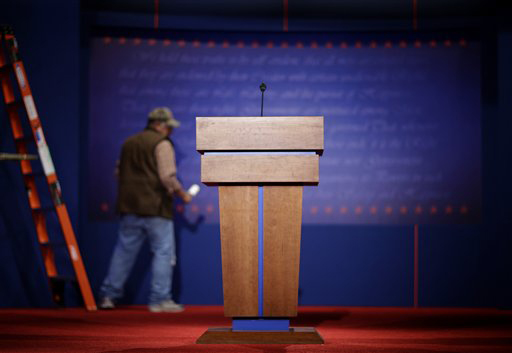President Barack Obama and Republican nominee Mitt Romney will meet tonight for the first time to go head-to-head over domestic policy issues. Moderating his 12th nationally televised presidential debate, PBS Executive Editor Jim Lehrer selected the topics to be covered, which include the economy, health care, the role of government and governing. The debate will take place from 9-10:30 p.m. Eastern Time at the University of Denver in Colorado.
Here are five more things you will need to know about tonight’s debate:
1. Format. The first debate will be divided into six, 15-minute segments. Lehrer will open each segment with a question, after which each candidate will have two minutes to respond. Lehrer will use the balance of the remaining time in the segment to further discuss the topic.
2. Social media as a fact-checking stream. More and more viewers now simultaneously turn to their televisions and computers for live event coverage; the debates will be no exception. Many voters will watch the debates on TV per usual, but will look to Twitter for fact-checking. As in 2008, journalists at the Tampa Bay Times’ PolitiFact will listen closely to the candidates for lines they have used before and quickly tweet links to fact-checks already written about those claims. The entire staff will work to post fact-checks to new claims the candidates make during the debate.
-

- A podium stands on stage as a worker cleans lint off the background for the first presidential debate of 2012, held at the University of Denver on Tuesday, Oct. 2. (David Goldman/AP)
“The debates are like the play-offs for us,” Editor Bill Adair told Poynter by telephone. “We will have a Twitter widget on the website so people can follow our fact-checks live. We will put up links very quickly to fact-checks we’ve already done, and by midnight or 1 a.m. we should have several more fact-checks published on the site. We’re going to be working into the wee hours and continue publishing new truth-o-meter items and then finish off on Thursday morning. This is really a big event for us and we’re going to be covering it in lots of ways.”
3. TV is still king, but… All three broadcast networks and the major cable news channels will air the debate live, according to schedules on their websites. But a growing number of voters will tune into the debates digitally. CNN.com will live-stream the debate on its website and on its mobile apps for iPhone and iPad.
And, the Commission on Presidential Debates announced last week a new digital initiative between AOL, Google’s YouTube and Yahoo. Called “The Voice Of…,” the initiative will feature the live debates and archival debate footage. The digital media companies “are collaborating to showcase an experience that will enhance every citizen’s ability to further their education on the issues and add a voice to the national conversation,” a press release states. Politico reports that Vice President Joe Biden will also host a livestream conversation with supporters across the country tonight.
4. Post-debate analysis. Young voters may not catch PBS or cable news analysis tonight, but they will likely tune in tomorrow to hear comedic commentary on Comedy Central’s “The Daily Show with Jon Stewart” and “The Colbert Report.” Unlike cable news programming, these two shows are actually growing audience and attracting younger viewers too.
Comedy Central is running ads challenging the trustworthiness of cable news channels and touting itself as a go-to place for election news. Stewart won’t just comment on the presidential contest, he will also participate by debating Fox News Channel’s Bill O’Reilly Oct. 6. That debate will also be live-streamed. Guardian reporter, Adam Gabbatt, will with a team of four others to provide a light alternative to serious news coverage by dropping animated GIFs onto Tumblr’s election blog as well as The Guardian’s live blog, reports Andrew Beaujon.
5. Political Parties. You will likely find journalists, political junkies, and those who want to be around them at debate-watching parties — similar to Super Bowl Parties, only bluer and redder. The Obama campaign says it will host 3,200 viewing parties across the country, while team Romney parties appear to be taking place in more suburban areas in key swing states like Virginia and Pennsylvania, Warren Rojas reported in Roll Call. Those left behind in Washington, D.C., who are not necessarily interested in ‘party’ partisanship, can check out more neutral revelries at the National Press Club. Everyone is welcome in the Bloomberg Room, while working journalists are likely to continue discussions of the debate over drinks in the members-only Truman Lounge.







